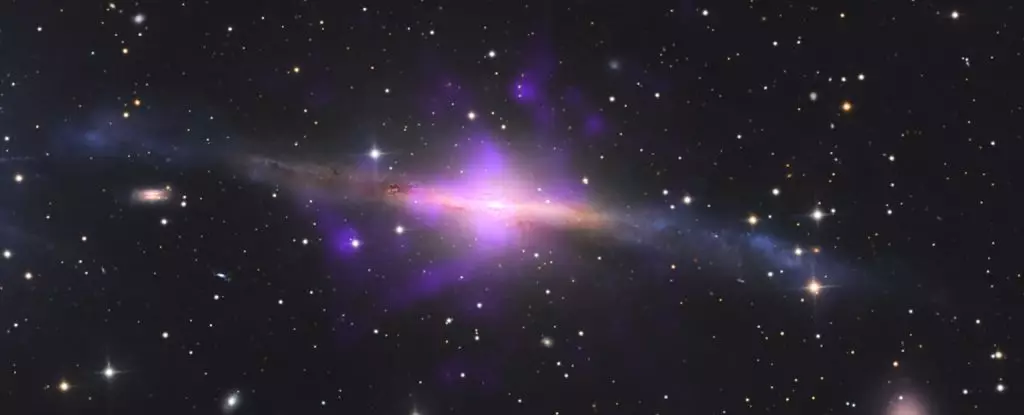In the vast universe, galaxies often hide enigmatic secrets beneath their glittering surfaces, and NGC 5084 is no exception. This lenticular galaxy, located approximately 80 million light-years away from the Milky Way, has captivated astronomers with its peculiarities, especially concerning its supermassive black hole. Recent findings suggest that this massive entity has tilted over, aligning itself parallel to the galactic plane—a cosmic anomaly that raises numerous questions about its origin and implications.
Discovered in 1785 by the prominent astronomer William Herschel, NGC 5084 has been the subject of extensive study over the centuries. As a lenticular galaxy, it occupies a unique position in the cosmic classification system; it features characteristics of both spiral and elliptical galaxies without distinct spiral arms. Stretching over 200,000 light-years in diameter and harboring a mass equivalent to approximately 1.3 trillion solar masses, NGC 5084 is one of the most massive galaxies of its kind known to scientists. However, despite its grandeur, the supermassive black hole at its core has remained relatively elusive, largely due to the challenges posed by its orientation and the surrounding dust.
Led by NASA Ames Research Center astronomer Alejandro Borlaff, a team of researchers embarked on a quest to uncover the mysteries hidden in the heart of NGC 5084. Utilizing both modern and archival observations, they applied advanced image analysis techniques to data collected from NASA’s Chandra X-ray Observatory. This method ultimately yielded surprising results—specifically, four long plumes of X-ray-emitting plasma that formed an X-shape extending from the galaxy’s center.
The appearance of these X-ray-emitting jets indicates the presence of past activity within the galactic core. Generally, when a supermassive black hole consumes surrounding matter, some of that material is expelled in the form of plasma jets along magnetic field lines from the poles of the black hole. Interestingly, two of the newly discovered plumes extended vertically from the galactic plane, while the other two were found embedded within it, sparking speculation about the black hole’s past orientation.
Seeking to uncover more about NGC 5084, the research team revisited archival data from long-term observations, including contributions from the Hubble Space Telescope and leading radio observatories such as the Atacama Large Millimeter/submillimeter Array. Borlaff remarked on the complexity of this astronomical investigation, likening it to piecing together a multifaceted crime scene. This integrated approach to data analysis allowed the researchers to confirm the existence of the plasma jets and investigate their origins in further detail.
What they discovered was revelatory: a band of dust surrounding the black hole, indicative of accreting material, was not aligned with the galactic plane as expected. Instead, it was oriented perpendicularly, reinforcing the hypothesis that the black hole has undergone a significant alteration in its positioning. This deviation is suggestive of past dynamic events within the galaxy, potentially involving a merger with another galaxy housing its own supermassive black hole.
While the definitive cause of the black hole’s peculiar tilt remains shrouded in mystery, the implication of a galactic merger presents a compelling narrative for researchers. In scenarios where two galaxies collide, their respective supermassive black holes may also interact, leading to complex gravitational dynamics and potentially upheaving the balance of their orbits. This could have resulted in the black hole in NGC 5084 changing its orientation considerably.
The research not only provided insights into the black hole’s behavior but also determined its mass for the first time, measuring it at 45.7 million solar masses. This newfound knowledge opens the door to further inquiries about the galaxy’s evolution and how it interacts with its surrounding environment.
The discovery of NGC 5084’s tilted supermassive black hole marks a significant milestone in the exploration of extragalactic phenomena. It challenges previously held notions of galactic structure and the behavior of black holes. Researchers like Pamela Marcum have emphasized the importance of these findings, noting the exceptional nature of detecting multiple pairs of X-ray jets in a single galaxy.
As astronomical technology continues to advance, there is hope that the mysteries of the universe will slowly unravel, revealing the intricate narratives that shape our cosmic landscape. NGC 5084 stands as a remarkable case study, underlining the potential for new discoveries in galaxies we have observed for centuries, highlighting the endless journey in our quest for understanding the universe.

